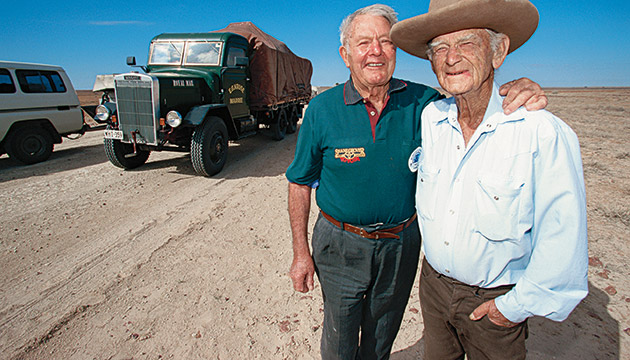It’s 80 years since Tom Kruse began delivering mail along the Birdsville Track, but the delivery of supplies remains no less important.
Story by John Dunn Photo by Leon Mead
Every Wednesday at Port Augusta Airport, in South Australia’s Mid North, Paul Daw, chief pilot of the charter company Hartwig Air, loads grey canvas bags into either a twin-engined Beechcraft Baron or a slightly bigger Piper Chieftain, climbs into the cockpit and heads inland. He’s on his way to do the mail run up the Birdsville Track, bringing letters and parcels to 15 stations scattered along 500 kilometres from Marree to Birdsville, just across the Queensland border.
Every second Wednesday, in the industrial Adelaide suburb of Penfield, Tom McKay and his son Will do another loading job, this time of cargo ranging from barrels of beer and machinery parts to tractor tyres and frozen food, onto a bulky semitrailer that will head north to the same destinations.
“They’re very happy to see you because mostly they’re depending very much on what you’re bringing,” Tom says. “We don’t want to let them down, but at times the track can be impassable and you can be stuck in the middle of nowhere for days. We always carry enough food and water for a week.”
Tom and his son are now doing what the legendary Tom Kruse and others did many years ago – providing vital supplies and much-needed postal items to the people of Birdsville who, despite huge advances in technology, still rely heavily on hands-on service that comes in trim, silver aircraft and on the tray and in the refrigerated compartment of lumbering trucks.
In his day, from 1936 to 1963, Kruse and some back-up drivers, usually Max Bowden, did both of these jobs alone. In a battered Badger diesel, carrying both mail and supplies, they struggled along the track, which was a harrowing trip across stony deserts, up and down steep sandhills and defying the varying surfaces of the Cooper and Diamantina rivers. They were constantly confronted by the worrying uncertainty of the weather conditions, an often deteriorating road surface that would bog up to the axles, and long delays waiting for broken parts to be replaced either by an interminable journey from the south or by time-consuming and difficult roadside repairs. The run up the track could take days, sometimes weeks.
Today it’s just hours for the flying postie and the general goods carrier. The track is in much better condition, making for an easier passage for the McKays, and fast communications provide advance warning about the hazards of rain-affected areas. Paul Daw’s quick and reliable aircraft have better station strips on which to land and he also has more accurate weather information.
This story excerpt is from Issue #111
Outback Magazine: Feb/March 2017









